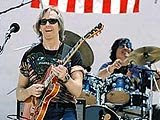My Writing Process, Part 5
 For rhythm or chordal roles, I stick with simple 2- and 3-note chords (often octaves or root-fifth inversions), and play a sparse pattern that creates a rhythmic counterpoint with the other instruments.
For rhythm or chordal roles, I stick with simple 2- and 3-note chords (often octaves or root-fifth inversions), and play a sparse pattern that creates a rhythmic counterpoint with the other instruments.Since there is no roadmap (that I know of) for writing guitar parts like this, it often takes a frustrating amount of experimentation before I happen upon something that works. However, over time, it has gotten a bit easier.
Creating a Latin Rock Groove
 Traditional Latin bands don't usually have a "kit" drummer. Instead, the combination of Timbales, Congas, and hand percussion forms a rhythmic tapestry that drives the music. However, Latin Rock dictates a heavy sound with a classic drum set. To make that work, you need to a drummer that knows how to play an open groove so that the percussion has room (our drummer happens to be very good at it -- a lucky break for us).
Traditional Latin bands don't usually have a "kit" drummer. Instead, the combination of Timbales, Congas, and hand percussion forms a rhythmic tapestry that drives the music. However, Latin Rock dictates a heavy sound with a classic drum set. To make that work, you need to a drummer that knows how to play an open groove so that the percussion has room (our drummer happens to be very good at it -- a lucky break for us).In addition, since the music we're playing has a rock flavor to it, the grooves are different than standard Latin grooves. So, there are a few basic formulas I use to create a groove.
1) Build it step by step. Starting with vocals, then the various instrumental lines, we experiment with various feels until we find one that works. Sometimes this takes a while!
2) Avoid guitar "strumming." It's so easy to play a typical rhythmic chord pattern on the guitar. Unfortunately, it seldom adds anything to the arrangement. When not playing melodies or arpeggiations ("montuno"), I pick unusual intervals and triads and focus on creating an open, distinctive rhythm. Often, this happens at the end, after the rest of the band figures out their parts.
3) Don't be afraid to "lay out." As musicians, we're used to playing every measure of every song. It's just habit. If a certain instrument is not needed in a certain part, don't force it! Just leave it out.


No comments:
Post a Comment